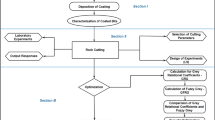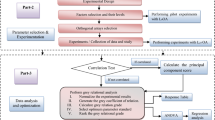Abstract
This study presents an approach to optimize machining parameters with multi-response output using an experimental design in high-speed milling. For the experimental design, planned experiments are based on Taguchi’s L9 orthogonal array. In processing difficult-to-machine materials such as 4Cr5MoSiV hardened steel after heat treatment, machining performance indicators such as flank wear, vibration, cutting force, and surface roughness have been measured and surveyed. Process parameters including depth of cut, feed rate, and cutting speed are optimized by considering multiple output parameters simultaneously by combining two algorithms of fuzzy grey relation analysis (FGRA) and particle swarm optimization (PSO) based on the Taguchi experiment. After the experimental processes, optimization is performed for the grey relational grade (GRG), with large GRG parameters showing better performance characteristics and accordingly the levels at which the maximum response is achieved will give the parameter optimized for the survey object. The analysis shows that the feed rate has the largest GRG index meaning that it plays the most important role in multi-objective optimization in high-speed milling of 4Cr5MoSiV steel, followed by depth of cut and finally cutting speed degree. The results of multi-objective optimization in high-speed milling of 4Cr5MoSiV materials by the proposed algorithm give the surface quality is improved by 11.11%, and tool wear, vibration amplitude, and force are reduced by 13.72, 15.78, and 16.59%, respectively. It is clear that the performance indicators are significantly improved using this method. Research shows that this method has given positive results in the application of optimized design of multi-objective technological parameters and has extraordinary suitability.











Similar content being viewed by others
Data availability
There is no need to mention the availability of data and materials in the present study.
References
A. P. M and C. D (2020) ANFIS modelling of mean gap voltage variation to predict wire breakages during wire EDM of Inconel 718. CIRP Journal of Manufacturing Science and Technology 31:153-164
Abhilash PM, Chakradhar D (2022) Multi-response optimization of wire EDM of Inconel 718 using a hybrid entropy weighted GRA-TOPSIS method. Process Integr Optim Sustain 6:61–72
Azizi A (2017) Introducing a novel hybrid artificial intelligence algorithm to optimize network of industrial applications in modern manufacturing. Complexity 2017:1–18
Bhatta G, De Los Santos Valladares L, Liu X, Ma Z, Bustamante Domínguez AG, Moreno NO et al (2021) Microstructure and mechanical properties of solid state recycled 4Cr5MoSiV (H11) steel prepared by powder metallurgy. Results in Materials 10:100184
Cheng Y, Luo X, Wang P, Yang Z, Huang J, Gu J et al (2022) Multi-objective optimization of thermal-hydraulic performance in a microchannel heat sink with offset ribs using the fuzzy grey approach. Appl Therm Eng 201:117748
Dar A, Anuradha N, “Use of orthogonal arrays and design of experiment via Taguchi L9 method in probability of default,” Accounting ISSN 2369–7407, vol. 4, pp. 113–122, 11/01 2017.
Hoang DT, Nguyen N-T, Tran QD, Nguyen TV (2019) Cutting forces and surface roughness in face-milling of SKD61 hard steel. Stroj Vestn J Mech Eng 65:375–385
Issa M, Helmi AM, Elsheikh AH, AbdElaziz M (2022) A biological sub-sequences detection using integrated BA-PSO based on infection propagation mechanism: case study COVID-19”. Expert Syst Appl 189:116063
Jiaqiang E, Zeng Y, Jin Y, Zhang B, Huang Z, Wei K et al (2020) Heat dissipation investigation of the power lithium-ion battery module based on orthogonal experiment design and fuzzy grey relation analysis. Energy 211:118596
Ju-Long D (1982) Control problems of grey systems. Syst Control Lett 1:288–294
Kumar J, Verma RK, Mondal AK (2021) Taguchi-grey theory based harmony search algorithm (GR-HSA) for predictive modeling and multi-objective optimization in drilling of polymer composites. Exp Tech 45:531–548
Kumar M (2020) Mechanical and sliding wear performance of AA356-Al2O3/SiC/graphite alloy composite materials: parametric and ranking optimization using Taguchi DOE and hybrid AHP-GRA method. SILICON 13:2461–2477
Kuram E, Ozcelik B (2013) Multi-objective optimization using Taguchi based grey relational analysis for micro-milling of Al 7075 material with ball nose end mill. Measurement 46:1849–1864
Li F, Peng F, Wang Y, Yan R, Li B (2014) Optimization of parameters of aircraft landing gear with orthogonal turn-milling based on GRA-PSO algorithm. Adv Mater Res 852:730–734
Li Y, Zou B, Shi Z, Huang C, Li L, Liu H et al (2021) Wear patterns and mechanisms of sialon ceramic end-milling tool during high speed machining of nickel-based superalloy. Ceramics International 47:5690–5698
Madić M, Petkovic D, Radovanović M (2014) GRA approach for multi-objective optimization of laser cutting. UPB Scientific Bulletin, Series D: Mechanical Engineering 76:79–90
Marakini V, Pai S, Bhat A, Bangera S (2021) Surface integrity optimization in high speed milling of AZ91 magnesium alloy using TOPSIS considering vibration signals. Materials Today: Proceedings
Nguyen D, Wu J, Quang NM, Duc LA, Son PX (2021) Applying fuzzy grey relationship analysis and Taguchi method in polishing surfaces of magnetic materials by using magnetorheological fluid. Int J Adv Manuf Technol 112:1675–1689
Ostad-Ali-Askari K, Shayannejad M, Eslamian S (2017) Deficit irrigation: optimization models (handbook of drought and water scarcity, vol. 3: management of drought and water scarcity), ed, pp. 373–389
Patel NS, Parihar PL, Makwana JS (2021) Parametric optimization to improve the machining process by using Taguchi method: a review. Materials Today: Proceedings 47:2709–2714
Pirnazar M, Hasheminasab H, Karimi AZ, Ostad-Ali-Askari K, Ghasemi Z, Haeri-Hamedani M et al (2018) The evaluation of the usage of the fuzzy algorithms in increasing the accuracy of the extracted land use maps. International Journal of Global Environmental Issues 17:307–321
Saputra OA, Wibowo FR, Lestari WW (2021) High storage capacity of curcumin loaded onto hollow mesoporous silica nanoparticles prepared via improved hard-templating method optimized by Taguchi DoE. Engineering Science and Technology, an International Journal
Shravani D, Lakshmi PK, Balasubramaniam J (2011) Preparation and optimization of various parameters of enteric coated pellets using the Taguchi L9 orthogonal array design and their characterization”. Acta Pharmaceutica Sinica B 1:56–63
Soorya Prakash K, Gopal PM, Karthik S (2020) Multi-objective optimization using Taguchi based grey relational analysis in turning of rock dust reinforced aluminum MMC. Measurement 157:107664
Srinivas Athreya V (2012) Application of Taguchi method for optimization of process parameters in improving the surface roughness of lathe facing operation. International Refereed Journal of Engineering and Science 1:13–19
Tien DH, Duc QT, Van TN, Nguyen N-T, Do Duc T, Duy TN (2021) Online monitoring and multi-objective optimisation of technological parameters in high-speed milling process. Int J Adv Manuf Technol 112:2461–2483
Tzeng C-J, Lin Y-H, Yang Y-K, Jeng M-C (2009) Optimization of turning operations with multiple performance characteristics using the Taguchi method and grey relational analysis. J Mater Process Technol 209:2753–2759
Ullah I, Zhang S, Zhang Q, Wang R (2021) Numerical investigation on serrated chip formation during high-speed milling of Ti-6Al-4V alloy. J Manuf Process 71:589–603
Varghese V, Ramesh MR, Chakradhar D (2018) Experimental investigation and optimization of machining parameters for sustainable machining. Mater Manuf Process 33:1782–1792
Wang B, Liu Z, Cai Y, Luo X, Ma H, Song Q et al (2021) Advancements in material removal mechanism and surface integrity of high speed metal cutting: a review. Int J Mach Tools Manuf 166:103744
Wang L, Liu H, Huang C, Niu J, Liu X, Yao P (2021) Three-dimensional transient cutting tool temperature field model based on periodic heat transfer for high-speed milling of compacted graphite iron. J Clean Prod 322:129106
Yan J, Li L (2013) Multi-objective optimization of milling parameters—the trade-offs between energy, production rate and cutting quality. J Clean Prod 52:462–471
Yin S, Nguyen D, Chen F, Tang Q, Duc LA (2018) Application of compressed air in the online monitoring of surface roughness and grinding wheel wear when grinding Ti-6Al-4V titanium alloy. Int J Adv Manuf Technol 101:1315–1331
Zhenchao Y, Yang X, Yan L, Jin X, Quandai W (2018) The effect of milling parameters on surface integrity in high-speed milling of ultrahigh strength steel. Procedia CIRP 71:83–88
Zhu L, Cui Y, Cao J, Tian R, Cai Y, Xu C et al (2021) Effect of TIG remelting on microstructure, corrosion and wear resistance of coating on surface of 4Cr5MoSiV1 (AISI H13). Surface and Coatings Technology 405:126547
Zhu W, Nikafshan Rad H, Hasanipanah M (2021) A chaos recurrent ANFIS optimized by PSO to predict ground vibration generated in rock blasting. Applied Soft Computing 108:107434
Funding
The work described in this paper was supported by Ha Noi University of Industry (HaUI) for a scientific project.
Author information
Authors and Affiliations
Corresponding author
Ethics declarations
Ethics Approval
There is no ethical approval needed in the present study.
Consent to Participate
There is no consent to participate needed in the present study.
Conflict of Interest
The authors declare no competing interests.
Additional information
Publisher's Note
Springer Nature remains neutral with regard to jurisdictional claims in published maps and institutional affiliations.
Rights and permissions
About this article
Cite this article
Tien, D.H., Van Bong, P. & Hung, L.T. Applying Improved Fuzzy Grey Relation Analysis Algorithm in Multi-objective Optimization for High-Speed Milling of 4Cr5MoSiV Steel. Process Integr Optim Sustain 6, 587–601 (2022). https://doi.org/10.1007/s41660-022-00238-2
Received:
Revised:
Accepted:
Published:
Issue Date:
DOI: https://doi.org/10.1007/s41660-022-00238-2




